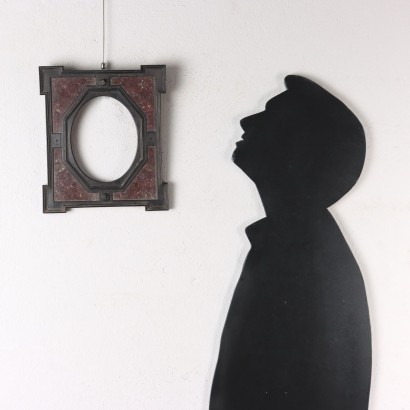Small Antique Mannerist Frame Oak Wood Marble Italy XVI-XVII Century - Italy XVI - First Half XVII Century
Features
Italy XVI - First Half XVII Century
Style: Mannerism (1520 - 1630)
Age: 17th Century / 1601 - 1700 , 16th Century / 1501 - 1600
Origin: Italy
Main essence: Ebony , Sessile Oak
Material: Marble
Description
Small Mannerist frame in ebony with commissary marble, Italy 16th - first half 17th century. Molded perimeter with protruding sections at the corners, 4 reserves in violet stain slab marble, molded octagonal frame placed in the center originally decorated with 4 small turned elements on the sides, 2 present with lacks while 2 completely absent, oval light. Restoration interventions of the late nineteenth century, added the oak bottom and replaced some ebony frames.
Product Condition:
Object that due to age and wear requires restoration.
Dimensions (cm):
Height: 28,5
Width: 25
Depth: 2
Additional Information
Style: Mannerism (1520 - 1630)
A complex and varied phenomenon, whose identifying traits can be seen in the artists' desire to resume the forms and styles of the Renaissance, leading however to an evolution.
In fact, if the original desire of many protagonists of this period is to produce works "in the manner of" masters such as Raphael or Michelangelo, the changed cultural conditions lead to outcomes that some scholars have defined as "anti-Renaissance".
This is because the tendency is to go beyond the search for a representation of man and nature as realistic and orderly as possible, introducing elements that will then be fully developed in the Baroque.
Find out more with our insights:
FineArt - Mannerism
The dictionary of antiques - Savonarola
The Austrian taste of Baroque
The charm of ancient Egypt
The rebirth of sacred art in the 17th century
Age:
17th Century / 1601 - 1700
17th Century / 1601 - 170016th Century / 1501 - 1600
16th Century / 1501 - 1600Main essence:
Ebony
Without any doubt it is one of the most precious and appreciated essences ever. Very hard and resistant, it is pleasant to the touch thanks to its smoothness, it is a wood with a typical black color. Being very rare it was traded as a precious metal and frequently forged. Because of its hardness, it is very difficult to work, which is why the term cabinetmaker, which indicates the very skilled craftsman in fine carpentry works, derives from this very essence. In modern times, it was introduced by the Flemings and Germans and immediately enjoyed success with the French. The golden period for Ebony was the Baroque, especially in the Boulle style workings. In general it is widely used in inlays, but also for furniture upholstery, for contrasting effects alongside brass, bronze and tortoiseshell.Sessile Oak
Under the name of oak or oak various types of woods derived from plants of the genus quercus are grouped. They are always resistant, hard and compact woods. Oak is lighter than oak, both are used for more rustic furniture or for the interiors of French and English antique furniture. In other processes it was gradually replaced by the advent of exotic woods considered more valuable since the 18th century.Material: Marble
Other customers have searched:
Se ti interessano specchi, specchiere, psiche, toilette, dai un'occhiata ai nostri approfondimenti sul blog e presentazioni su FineArt
Leggi di più
Una coppia di specchiere a cavallo tra barocco e barocchettoIl nuovo gusto nel Granducato di Toscana tra Rococò e Neoclassicismo in una specchiera intagliata
Una elegante specchiera intagliata e dorata, espressione dello stile Regency
Il fascino senza tempo della Toilette
Un reimpiego di qualità: da trumeau a specchiera
Caminiera Neoclassica, Firenze, ultimo quarto XVIII secolo
Specchiera Neoclassica, Firenze, fine XVIII secolo
Coppia di Specchiere Irlandesi, in Stile Giorgio III, seconda metà XIX secolo
Specchiera Cinese, Ultimo Quarto XVIII Secolo
Consolle Parietale con specchi
Consolle inglese, metà XIX secolo con specchi
Caminiera Impero, Lombardia, primo quarto XIX secolo
Psiche Impero, Francia, primo quarto XIX secolo
Cornice laccata, Veneto, ultimo quarto XVIII secolo
Specchiera Barocca, Bologna Inizio XVIII Secolo
Specchiera a Cassetta, Bologna Inizio XVIII Secolo
Cornice edicola, Venezia, XVI secolo
Sull'antiquariato in generale dai un'occhiata anche a:
Classic Monday: da un pezzo dei nostri magazzini alla storia dell'antiquariato
L'antiquariato dalla A alla Z: il Dizionario dell'Antiquariato
Il dizionario dell'antiquariato - Lastronatura
Il dizionario dell'antiquariato - Mascherone
Il dizionario dell'antiquariato - Natura morta
Il dizionario dell'antiquariato - Opificio
Il dizionario dell'antiquariato - Pastiglia
Il dizionario dell'antiquariato - Savonarola
Il dizionario dell'antiquariato - Rosone
Intaglio barocco con motivo a ricciolo
Product availability
The product can be seen at Cambiago
Immediate availability
Ready for delivery within 2 working days from ordering the product.













































